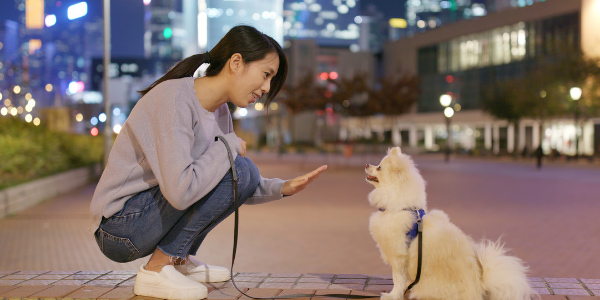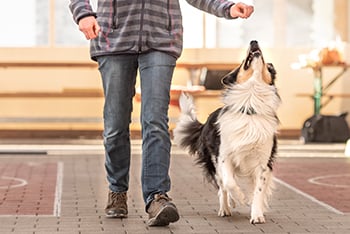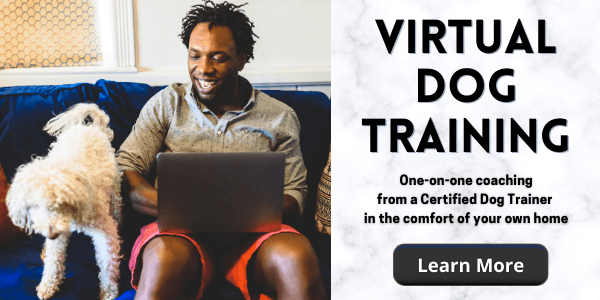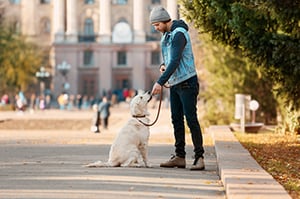 Do you want to teach your dog a neat new trick? Are you just getting started with puppy training and want to teach your dog the basics?
Do you want to teach your dog a neat new trick? Are you just getting started with puppy training and want to teach your dog the basics?
I’m going to let you in on a dog trainer secret — when teaching dogs a new skill, no matter how simple or complex the behavior we want to train, we follow the same process every time. And once you learn this process, you can teach your dog anything!
One of my goals as a dog trainer is to equip my human students with the tools to understand how dogs learn and the training mechanics for them to easily and effectively put into practice on their own. This means they'll have the means to train their dog for life, not only building a robust human-canine relationship but also helping to prevent problem behaviors. This empowers them to pursue lots of different activities with their dogs, from competition obedience to other dog sports like Canicross, Flyball, or Agility.
Let’s look at the process of how to teach your dog to do anything. Once you know these 4 steps, all you need is some creative thinking, problem-solving skills, and practice!
Step One: Define the Behavior
Step Two: Make the Behavior Happen
Step Three: Reward the Behavior
Step Four: Repeat & Generalize
Step One: Decide What You Want to Train
This first step is pretty essential. If you don’t know what you want, it’s going to be really hard for your dog to figure it out! When deciding what you’re going to teach your dog, you need to frame it a certain way — don’t think about what you want your dog to stop doing.
We humans often fall into the trap of saying, “I want my dog to not jump on people,” or “My dog needs to stop pulling on the leash.” You cannot train the absence of something. You must give your dog clear criteria for a behavior that is incompatible with any unwanted behavior.
These are not necessarily the same training plan steps a dog trainer or canine behavior consultant would rely on for behavior modification (such as leash reactivity, fear aggression, resource guarding, or anxiety).
Connect with a certified dog trainer or behavior consultant near you if your dog is struggling with these types of behaviors to begin a personalized behavior modification plan with your dog.
Examples of clearly-defined dog training goals:
- I want to teach my dog to sit when greeting people.
- I want to teach my dog to spin in a full circle to their right.
- I want to teach my dog to walk at my pace within one foot of my left side when on leash.
- I want to train my dog to go open the refrigerator, grab me a beer from the lower shelf and bring it to me, making sure to close the fridge door behind him.
These are all actions your dog can take and are well-defined, even though some are more complicated behaviors than others. No matter how complex a new behavior might seem, you’ll approach it the same way as a simple behavior.
The only difference is that you train the full behavior in small slices, chaining the steps together as your dog learns — we'll get more in-depth on this during the next step.
Step Two: Make the Behavior Happen
Now it’s time to bust out some creative thinking. Some behaviors, such as sit or down, happen more often and more naturally than your dog walking on a loose leash. In order to learn a new behavior, a dog must be reinforced for it. To reinforce the behavior, it's got to happen first! We have a few different ways to “make” a behavior happen:

Environmental Set-Up
Build an environment where the behavior is easier to perform naturally or with the help of luring or shaping (which are explained below). Having environmental guides to encourage specific movements or positioning stacks the deck in your favor.
Examples of using environmental setups in training:
- You’re teaching your dog to spin in a circle to their right. Set up an exercise pen in a large circle. Place a cone in the center for your dog to move around. The circle they make might be large at first, but with practice, it will become smaller and smaller, turning into a tight spin to the right with no cone or exercise pen panels.
- Use a long hallway and use the walls as a natural boundary that helps your dog learn correct heel positioning. This is especially helpful when you’re practicing heel with the dog closer and closer to your leg.
- Set up a baby gate that your dog is behind whenever guests enter your home. This gives guests protection from a jumping dog and an opportunity to request a sit. They then can reward a sit with a treat and/or attention. Sitting also can be the behavior that means the gate is opened for them.

Guide your dog into position or through the movement of the behavior with a lure. This is most easily done with a food treat, but can also be done with a toy or with nothing in the hand at all once a dog has learned how to follow hand prompts.
A food lure is when you have a treat in a closed hand, and that hand guides the dog into the desired position. A dog is likely to follow a food lure because they can smell the treat, and if you can control where their head goes, you can control how their body moves or is positioned.
When first introducing a new behavior to your dog, sometimes it takes practice to get the lure just right in positioning and speed. For instance, if you're teaching your dog to sit when they greet someone, you'll place the lure right in front of their nose and slowly move it over their head (between their ears). The dog should follow the lure with their nose, causing their rear end to hit the floor.
Sometimes, however, we move the treat back too quickly or position too high, and the dog jumps up towards it or moves around to try and find it rather than sitting. It takes practice to find the exact speed and positioning of your lure. If your dog isn't following a food lure or hand prompt well, try moving slower or keeping your hand closer to their nose as you move it.
Watch this video to see Mary Berry learn the basics of following a lure:
Shape the Behavior
Shaping is a fun and incredibly effective dog training method, fully utilizing the power of marker training (clicker training). If you and your dog are familiar with the clicker, you can teach more complex behaviors with shaping. Shaping means you take a behavior and slice it into smaller, more manageable actions.
For example, if you're teaching your dog to fetch a drink from the fridge for you, you could train the entire behavior in these seven steps:
- Taking a step towards the refrigerator
- Grabbing a rope attached to the fridge handle
- Pulling on a rope or towel to open the door
- Grabbing onto the beverage (gently!)
- Pulling the beverage out of the fridge
- Closing the fridge
- Bringing the drink to you
You can even slice these portions of the entire behavior into smaller pieces. By focusing on easy steps one by one, your dog will be more successful and learn the whole process faster because they understand each action of the sequence.
Shaping can be done in conjunction with a lure, which can be especially helpful if a dog isn't wanting to follow a lure into a certain position like down.
Trainer Note: Make sure your dog isn't avoiding certain positions or movements during training due to being in pain or injured. Check out this article on how to tell if your dog might be in pain.
One of my favorite ways to train is called Free Shaping, where the dog is offering behaviors in an effort to get the click without any prompting or lure. I find that this keeps a dog engaged in the training process and really builds their problem-solving skills! Want to see free shaping in action? Check out this video:
Capture the Behavior
Capturing a behavior means that you wait until the action naturally occurs on its own, allowing you to reinforce it. Most recently, I've been using the capturing method with my dog to work on her "stretch" trick. I haven't been able to successfully lure or prompt the positioning of this cue, thanks to her long Corgi body and short legs.
She has a tendency to just lay down with no intermediary bow or stretch position from the stand. Whenever I see her naturally stretching, usually whenever she gets up from her dog bed, I take the opportunity to name it and reward it. Sometimes I give just praise and petting, or more often, I mark with a "yes" or click and then give her a treat. Watch this video to see what capturing looks like:
Step Three: Mark and Reinforce the Behavior
The more a behavior is reinforced (whether with a food reward or something else that the dog finds valuable), the more it will be repeated. It's up to us to make sure we're reinforcing the behaviors we want our dogs to learn so they will choose to do them more often and when asked.
This is where your clicker (or marker word such as saying "click" or "yes") is going to do all the heavy lifting for you. When your dog is performing the new behavior, mark it with a click or word, then give them a treat. And repeat!
Don't worry about giving the behavior a verbal cue until your dog is reliably performing it. Then, once they understand the action that's getting the click, start saying the cue (such as "Sit") as they are sitting down. Then click and treat!
Dogs learn by association. With practice, you'll be able to give them the verbal cue without any luring, and they'll perform the behavior because they have associated the word with the action.
Your click or "yes!" is telling your dog precisely what action is getting them the treat reward — it's acting as a bridge, giving you time to reward them with the treat. If you were not using a marker in training, the reinforcement (treat) needs to be given instantaneously with the action you're wanting to reinforce, which can be hard!
Your dog will learn faster if there is clear communication. Check out this article to see how easy it is to start using a clicker in your training.
When first training a new behavior, I recommend starting with luring but moving into shaping as quickly as you can. This way you're utilizing the clicker to its full potential, and your dog is learning important problem-solving skills that will make future training easier! Click here for more information about using a clicker with luring versus shaping methods.
Step Four: Practice and Generalize the Behavior
Once you've gotten started with the above steps, then it all comes down to repetition and practice. You'll want to practice the behavior around low distractions at first before slowly adding in busier, and therefore harder, environments. Walking on a loose leash at home is easier for your dog than walking on a loose leash in the park — there's all those smells and squirrels to contend with!
Once your pup has got the hang of the skill around no to low distractions, then make it a little bit harder. After walking on a loose leash inside, take it out to your driveway or the sidewalk in front of your home. Then around the block. This is called generalization, where your dog is learning that this new behavior is rewarding no matter where they are! Once a behavior has been generalized, you can then begin to fade out training treats in the environments where your dog is reliably performing the cue.
By following the general steps outlined above, you can teach your dog to do anything you can imagine (within their physical abilities, of course)! Training your dog to do things you like means that you can ask them for alternative and incompatible options to prevent unwanted behaviors, such as sitting in front of guests instead of jumping on them, or walking nicely on lead instead of dragging you down the street. If you need help getting started, connecting with a certified dog trainer can help you and your dog work as a team and will give you the chance to learn training skills that will last a lifetime.
We want to know what cool and unique tricks or behaviors you've trained your dog to do — share them with us in the comments below!





